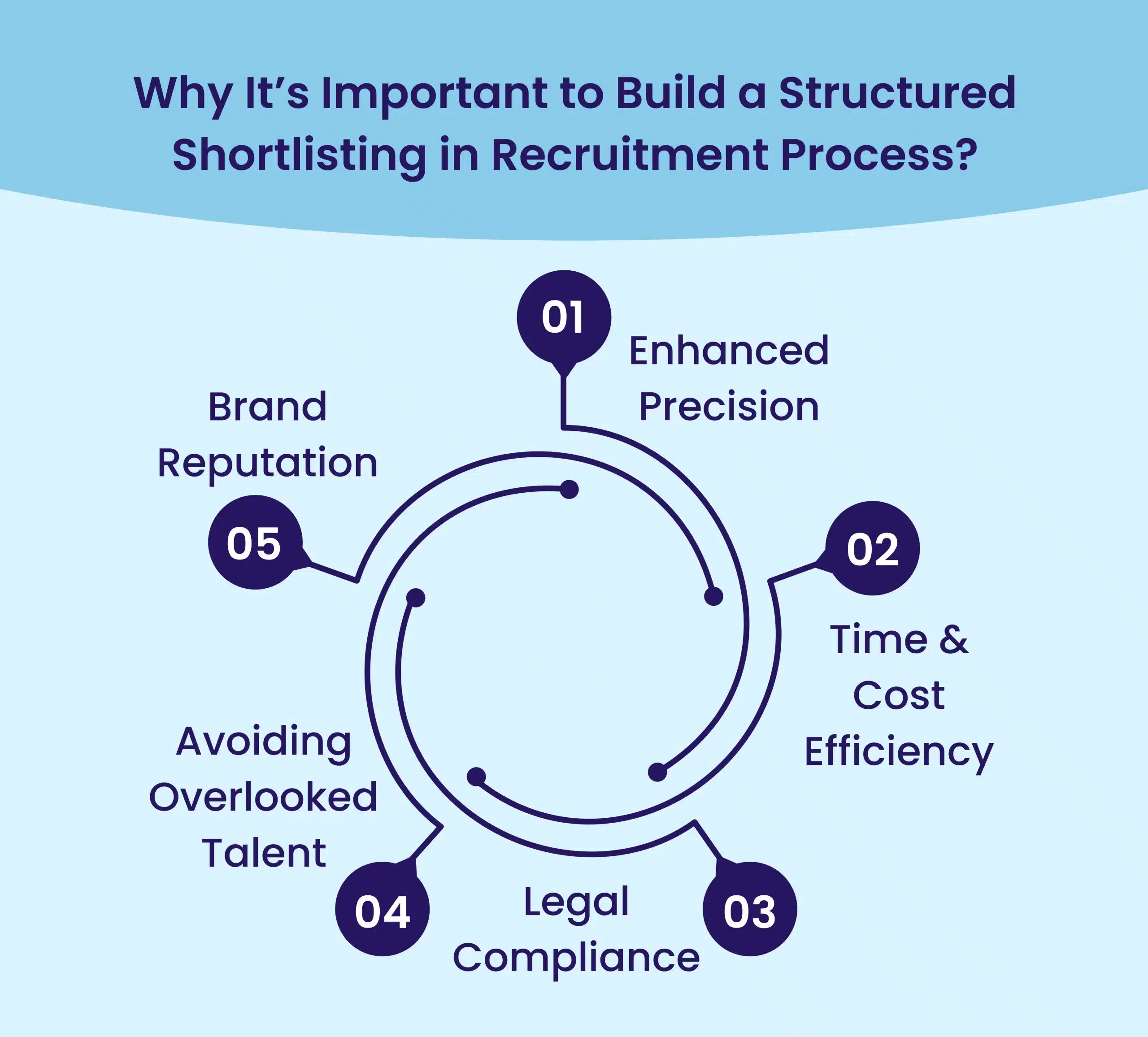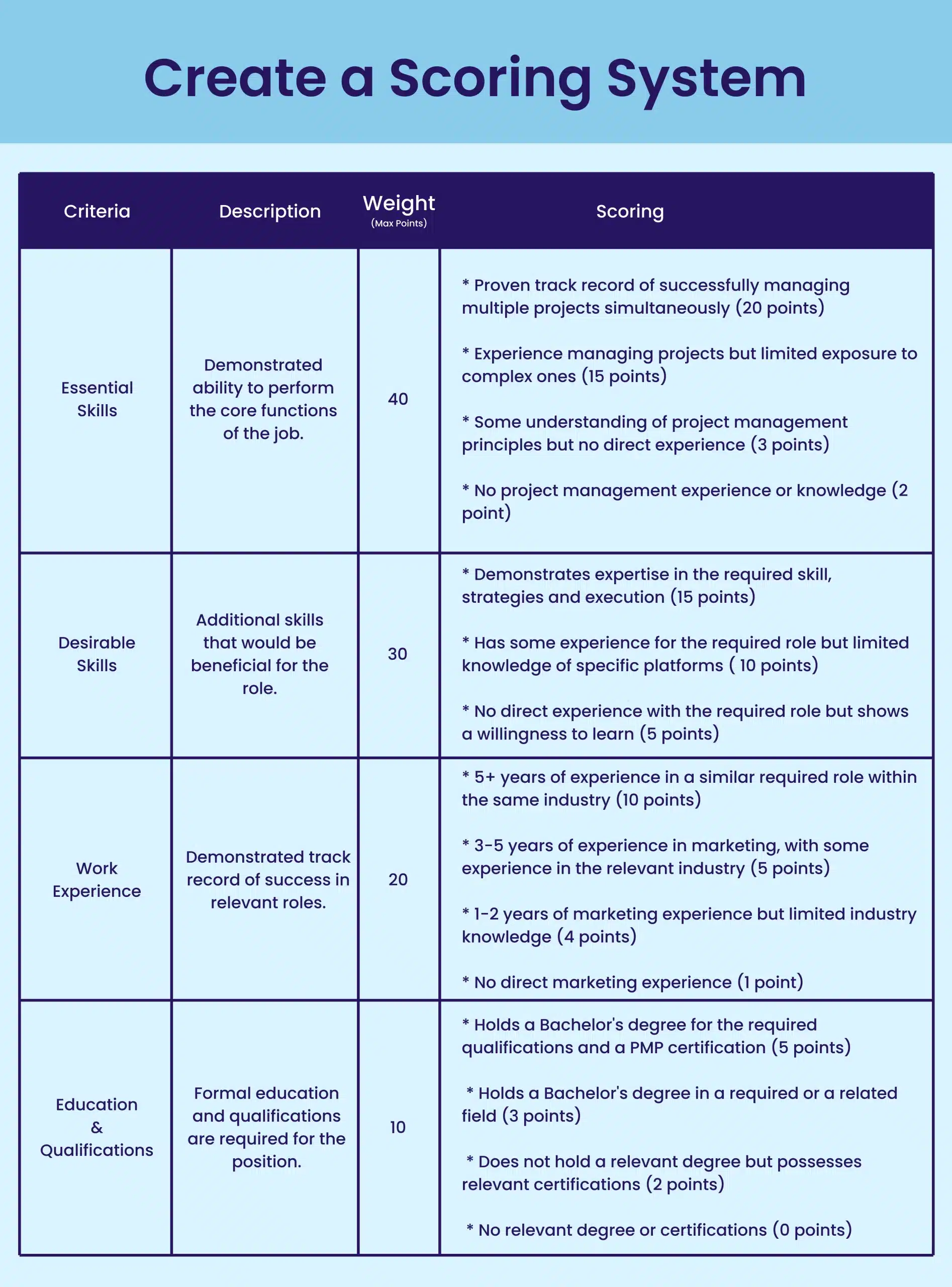Table of content
Are you struggling with the daunting task of shortlisting candidates for the next stage of the recruitment process? Shortlisting is a crucial stage in which employers identify the candidates from their applicant pool who best meet the essential and desirable criteria for the job opening in question.
The shortlisting process is a delicate balancing act that requires a keen eye for detail and an unwavering commitment to fair play. Steering clear of unlawful discrimination is not just a legal mandate but a moral responsibility, ensuring every candidate is given an equal shot at proving their worth.
This blog post will guide you through the essential principles of shortlisting, the ideal shortlisting process, and how to pay attention to the best candidates.
Let’s get started!
Why It’s Important to Build a Structured Shortlisting in Recruitment Process?
Building a structured approach to shortlisting in recruitment is akin to laying a solid foundation for a skyscraper. Just as a sturdy foundation ensures the stability and longevity of a towering structure, a well-defined shortlisting strategy underpins the success of the recruitment journey. Here’s why it’s crucial:
Enhanced Precision: A structured shortlisting process acts as a fine sieve, ensuring that only the most suitable candidates pass through. It’s about quality over quantity, focusing on the depth of each application and aligning it with the job’s essential and desirable criteria.
Time and Cost Efficiency: By streamlining the shortlisting phase, organizations can significantly reduce the time and resources spent interviewing unsuitable candidates. This efficiency saves costs and accelerates the overall recruitment timeline, allowing businesses to fill vacancies with agility.
Legal Compliance: A structured approach provides a clear, objective framework that can be consistently applied across all candidates. This minimizes the risk of unconscious bias and unlawful discrimination, ensuring a fair, transparent, and legally defensible selection process.
Brand Reputation: How candidates are shortlisted reflects on the company’s brand. A fair and structured process enhances the employer’s image, making it more attractive to top talent who value integrity and professionalism in potential employers.
Avoiding Overlooked Talent: Without a structured process, there’s a risk of missing out on hidden gems—candidates who may not stand out at first glance but possess the potential to excel. A systematic approach ensures that every application is given due consideration, preventing exceptional talent from slipping through the cracks.
5 Steps to Effective Shortlisting in Recruitment Process
Shortlisting in recruitment process is like a journey that needs a map and a compass. It’s about knowing where you’re going and how to get there efficiently. Here are five steps to make sure that your shortlisting is not only effective but also a shining example of best recruitment practices:
Define Clear Criteria: Before reviewing job applications, ensure you have a clear set of criteria in place. These criteria should be based on the job description and person specification to ensure that the shortlisting process aligns with the role’s requirements and the company’s culture.
Create a Scoring System: Implement a scoring system to evaluate candidates objectively. This could involve a simple scale rating each applicant against the defined criteria. Consistency is key here, ensuring all candidates are assessed on an even keel.
Review and Rate Applications: With your scoring system in place, begin the review process. Rate each application according to how well it meets the criteria. This step is crucial in the shortlisting in recruitment process as it transforms subjective impressions into objective data.
Conduct Initial Screening Calls: Sometimes, a paper application doesn’t tell the whole story. Conduct brief screening calls to clarify uncertainties and gauge the candidate’s communication skills and enthusiasm for the role.
Refine Your Shortlist: After scoring and initial calls, refine your list. This might mean revisiting your scores or discussing with colleagues to ensure no potential star is left behind. Remember, effective shortlisting in recruitment is about quality, not just quantity.
Shortlisting Pitfalls: Common Mistakes to Avoid in Recruitment
Shortlisting in recruitment process is critical, acting as a bridge between a vast applicant pool and your ideal candidates. However, this process can take time and effort. Here are some common mistakes to avoid to ensure your shortlisting is effective, efficient, and fair:
Unclear Criteria
Rushing into the shortlisting process without clearly defined criteria is a recipe for disaster. Take the time to revisit the job description and person specification. Identify the essential and desirable skills, experience, and qualifications needed for the role. This serves as your roadmap, ensuring everyone involved is on the same page.
Inconsistent Scoring
Implementing a scoring system is a great way to evaluate candidates objectively. However, inconsistency in applying the scoring rubric can lead to biased decisions. Ensure everyone involved in the shortlisting process receives training on using the scoring system consistently. Regular calibration sessions also help maintain consistency and identify potential areas for improvement.
Rushing Through Reviews
Speed and thoroughness are important. Don’t skim through applications—take the time to review each one carefully based on your defined criteria. Pay attention to both the content and the quality of the application itself. This can reveal a candidate’s attention to detail and work ethic.
Focusing Solely on Resumes
Resumes are a starting point, not the finish line. While a strong resume is important, it can sometimes overlook a candidate’s true potential. Consider including additional selection methods like skills tests or portfolio reviews to better understand a candidate’s abilities.
Unconscious Bias
Implicit biases can creep into the shortlisting process, leading to the exclusion of qualified candidates. Be mindful of your biases and those of colleagues involved in the process. To mitigate this risk, use anonymous resume reviews (where names and other identifying information are removed).
Ignoring Red Flags
Sometimes, red flags jump out from a resume or cover letter. These could be inconsistencies in employment history, significant gaps in experience, or unprofessional communication. While you shouldn’t automatically disqualify a candidate based on a single red flag, it’s essential to investigate further and weigh the potential risks.
Not Providing Feedback
Even if a candidate isn’t shortlisted, consider providing brief feedback. This demonstrates professionalism and allows them to improve their application for future opportunities. A simple automated email thanking them for their interest and letting them know they haven’t been shortlisted is a good starting point.
Taking Too Long
While a thorough review is important, avoid taking excessive time to shortlist candidates. Aim to establish a clear timeline for the recruitment process and communicate it to applicants. A prompt response demonstrates respect for their time and effort.
Conclusion
The art of shortlisting is an essential part of the recruitment process that demands meticulous attention and a principled approach. By following a structured shortlisting strategy, organizations can enhance the precision of their candidate selection, optimize time and cost efficiency, ensure legal compliance, strengthen their brand reputation, and prevent the oversight of exceptional talent.
Remember, the goal is not just to fill a vacancy but to discover a candidate who will thrive and contribute to the company’s success. A well-executed shortlisting process is a critical step towards this end, ensuring that each candidate’s potential is thoroughly evaluated and the best are brought forward to the next stage.



